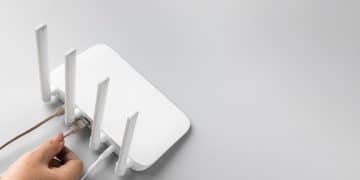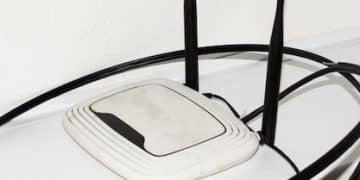Optimize Your Wi-Fi: Antenna Placement and Channel Selection Tips

Optimize Your Wi-Fi Signal Strength: A Guide to Antenna Placement and Channel Selection, involves strategically positioning your router’s antennas and selecting the optimal channel to minimize interference and maximize network performance.
Is your Wi-Fi feeling sluggish? Learn how to optimize your Wi-Fi signal strength: a guide to antenna placement and channel selection for a faster, more reliable connection.
Understanding Wi-Fi Signal Strength
Before diving into optimization, it’s crucial to understand what constitutes a strong Wi-Fi signal and the factors that influence it. A robust signal ensures smooth streaming, lag-free gaming, and quick downloads, improving overall online experience.
Several elements affect Wi-Fi strength, including distance from the router, physical obstructions, and electromagnetic interference. Understanding these aspects allows for targeted adjustments for signal improvement.
Factors Affecting Wi-Fi Signal Strength
Several factors can degrade your Wi-Fi signal, leading to slower speeds and dropped connections. Here are some key culprits:
- Distance: The further you are from the router, the weaker the signal gets. Wi-Fi signals have a limited range.
- Obstructions: Walls, floors, and furniture can block or weaken the Wi-Fi signal. Materials like concrete and metal are particularly problematic.
- Interference: Other electronic devices, such as microwaves and cordless phones, can interfere with Wi-Fi signals. Also, neighboring Wi-Fi networks can cause congestion.
- Router Placement: Hiding your router in a cabinet or placing it on the floor can weaken its signal.
Recognizing these hindrances will allow you to mitigate them. Tweaking router position, minimizing obstructions, and tackling interference can significantly boost the Wi-Fi signal quality.

Optimal Antenna Placement Techniques
The placement of your router’s antennas greatly influences how the Wi-Fi signal is distributed throughout your home or office. Correct orientation and positioning can create a uniform and strong network coverage.
Most routers have adjustable antennas that can be directed to optimize coverage. Experimentation with antenna angles can notably improve signal strength in different areas.
Antenna Orientation and Coverage
Understanding how antennas radiate signals is key to proper placement. Most routers use omnidirectional antennas, which radiate signals in all directions. However, the orientation affects the signal pattern:
- Vertical Antennas: Best for horizontal coverage, ideal for single-story homes or when devices are on the same floor as the router.
- Horizontal Antennas: Better for multi-story buildings, as the signal is distributed vertically.
- Adjustable Antennas: Allow for fine-tuning the signal to target specific areas. Try angling one antenna vertically and another horizontally for broader coverage.
By adjusting antenna placement, you can customize wireless service to suit your environment. Make use of adjustable antennas for optimum performance in every corner of the building.
Understanding Wi-Fi Channels
Wi-Fi channels are sub-divisions of the 2.4 GHz and 5 GHz frequency bands used by wireless networks. Selecting an uncongested channel can significantly reduce interference and improve network speeds.
By understanding the spectrum available and the level of crowding within each channel, you can minimize overlaps and optimize signal performance.
Importance of Channel Selection
Think of Wi-Fi channels like lanes on a highway. If everyone is using the same lane, traffic slows down. Similarly, if many Wi-Fi networks are using the same channel, interference occurs, reducing your network speed and reliability. Some points to consider:
- Minimize Interference: Choosing a less crowded channel reduces interference from other networks.
- Channel Overlap: In the 2.4 GHz band, channels overlap, causing interference even if you’re not on the exact same channel. Channels 1, 6, and 11 are the most common and least overlapping.
- 5 GHz Advantages: The 5 GHz band has more channels and less overlap, providing a cleaner spectrum for faster speeds.
Careful channel selection can give a significant boost to Wi-Fi efficiency, particularly in the crowded 2.4 GHz space.

Utilizing Wi-Fi Analyzer Tools
Wi-Fi analyzer tools are essential for identifying the least congested channels and assessing signal strength in various locations. These tools provides insights to aid decision-making in optimizing your Wi-Fi settings.
Available on smartphones, tablets, and computers, these apps make it straightforward to identify the most suitable channels and better understand your network.
How to Use a Wi-Fi Analyzer
Wi-Fi analyzers scan the wireless environment and display the channels used by nearby networks, along with their signal strengths. Here’s how to use them effectively:
- Download and Install: Choose a reputable Wi-Fi analyzer app for your device. Popular options include Wi-Fi Analyzer (Android) and NetSpot (Windows/macOS).
- Scan Your Network: Run the app and let it scan for nearby Wi-Fi networks.
- Identify Congested Channels: The app will display a list of channels and their usage. Look for the channels with the fewest networks and the lowest signal strengths.
- Change Your Router’s Channel: Access your router’s settings page through a web browser. Navigate to the wireless settings and change the channel to the least congested one.
Routine use of Wi-Fi analyzers is a sustainable plan to adjust your network and keep your Wi-Fi operating at optimal quality. Periodically reassess and fine-tune to counter emerging interference.
Advanced Router Settings for Enhanced Performance
Exploring advanced router settings can further enhance your Wi-Fi performance. Options such as Quality of Service and beamforming can greatly influence network responsiveness and coverage.
Delving into your router’s administrator interface unveils a variety of sophisticated tools to prioritize traffic and focus the signal precisely.
Exploring Advanced Features
Many modern routers offer advanced features that can help optimize your Wi-Fi network. Here are a few to consider:
- Quality of Service (QoS): Allows you to prioritize certain types of traffic, such as video streaming or online gaming, ensuring they receive more bandwidth.
- Beamforming: Focuses the Wi-Fi signal towards connected devices, improving signal strength and reliability.
- Guest Network: Creates a separate network for guests, preventing them from accessing your main network and sensitive data.
- MU-MIMO (Multi-User, Multiple-Input, Multiple-Output): Allows the router to communicate with multiple devices simultaneously, improving overall network efficiency.
Familiarize yourself with the advanced options that your router has to grant a more refined and optimized Wi-Fi environment.
Dealing with Physical Obstructions
Physical obstructions such as walls, furniture, and appliances can significantly diminish the strength of the Wi-Fi signal. Knowing how to navigate these obstacles is essential for maximizing coverage.
Relocation of routers and thoughtful placement of furniture can help minimize their impact, keeping the signal stable and consistent.
Strategies for Overcoming Obstructions
Physical obstructions can block or weaken Wi-Fi signals, but there are several strategies you can use to mitigate their effects:
- Elevate Your Router: Place your router on a high shelf or mount it on a wall to minimize obstructions.
- Avoid Metal and Concrete: Keep your router away from metal objects (like filing cabinets and large appliances) and concrete walls, as these materials can significantly block Wi-Fi signals.
- Central Location: Position your router in a central location in your home to provide the best possible coverage to all areas.
By being proactive in handling obstructive elements, you strengthen the effectiveness of your Wi-Fi signal, achieving consistent connectivity throughout your location.
| Key Point | Brief Description |
|---|---|
| 📡 Antenna Placement | Adjust antennas for optimal coverage. Vertical setup suits single-story homes. |
| 📶 Channel Selection | Choose less congested channels to minimize interference. Use Wi-Fi analyzers for guidance. |
| 🛠️ Router Settings | Utilize QoS and beamforming for better performance. Keep firmware updated. |
| 🧱 Overcome Obstructions | Elevate router, avoid metal/concrete, and position centrally. |
Frequently Asked Questions
▼
To access your router’s settings, type its IP address (usually 192.168.1.1 or 192.168.0.1) into a web browser. You’ll need the router’s username and password, often found on a sticker on the router.
▼
The best channel depends on your environment. Use a Wi-Fi analyzer to find the least congested channel. In the 2.4 GHz band, channels 1, 6, and 11 are commonly recommended.
▼
It’s a good practice to update your router’s firmware whenever updates are available. These updates often include security patches and performance improvements, enhancing overall network reliability.
▼
Yes, a Wi-Fi extender can boost signal strength by rebroadcasting the signal from your router. Place it halfway between the router and the area with poor coverage for best results.
▼
MU-MIMO (Multi-User, Multiple-Input, Multiple-Output) allows your router to communicate with multiple devices simultaneously, improving network efficiency and reducing lag, especially with many connected devices.
Conclusion
By strategically adjusting antenna placement, selecting optimal channels, utilizing advanced router settings, and addressing any physical obstructions, you can significantly optimize your Wi-Fi signal strength and improve your overall wireless experience. This guide provides you with useful knowledge to achieve optimum Wi-Fi performance for everyday usage.





